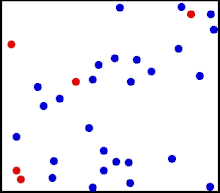File:Translational motion gif.ogv
Translational_motion_gif.ogv (קובץ וידאו Theora של Ogg, באורך 19 שניות, 300 × 264 פיקסלים, 212 קילו־ביטים בשנייה, גודל הקובץ: 481 ק"ב)
כיתובים
כיתובים
תקציר
[עריכה]| תיאורTranslational motion gif.ogv |
Motion of gas molecules Español: Animación mostrando la agitación térmica de un gas. Cinco partículas han sido coloreadas de rojo para facilitar el seguimiento de sus movimientos.
Русский: Хаотическое тепловое движение на плоскости частиц газа таких как атомы и молекулы |
| תאריך יצירה | (original) 2010-04-09 (converted to OGV) |
| מקור |
קובץ זה הוא יצירה נגזרת של : Translational motion.gif English: Converted as follows:
|
| יוצר | A.Greg, en:User:Greg L |
| גרסאות אחרות |
 |
Translational motions—the randomized thermal vibrations of fundamental particles such as atoms and molecules—gives a substance its “kinetic temperature.” Here, the size of helium atoms relative to their spacing is shown to scale under 1950 atmospheres of pressure. These room-temperature atoms have a certain, average speed (slowed down here two trillion fold). At any given instant however, a particular helium atom may be moving much faster than average while another may be nearly motionless. The rebound kinetics of elastic collisions are accurately modeled here. If the velocities over time are plotted on a histogram, a Maxwell-Boltzmann distribution curve will be generated. Five atoms are colored red to facilitate following their motions.
Note that whereas the relative size, spacing, and scaled velocity of the atoms shown here accurately represent room-temperature helium atoms at a pressure of 1950 atmospheres, this is a two-dimensional scientific model; the atoms of gases in the real world aren’t constrained to moving in two dimensions in windows precisely one atom thick. If reality worked like this animation, there would be zero pressure on the two faces of the box bounding the Z-axis. The value of 1950 atmospheres is that which would be achieved if room-temperature helium atoms had the same inter-atomic separation in 3-D as they have in this 2-D animation. p=nm¯c2/3V , where ¯c2 is the mean square speed of the molecules. As according to the gas laws for one mole of gas: pV=RT, where T is the thermodynamic temperature, and R is the molar gas constant, it follows that: RT=nm¯c2/3 Thus, the thermodynamic temperature of a gas is proportional to the mean square speed of its molecules. As the average kinetic energy of translation of the molecules is m¯c2/2, the temperature is given by: T=(m¯c2/2)(2n/3R)
רישיון
[עריכה]| Public domainPublic domainfalsefalse |
יצירה זו של צורה גאומטרית פשוטה היא נטולת זכויות יוצרים ומשום כך היא ברשות הציבור. היצירה מורכבת כולה, מיֶדַע שהוא נחלת הכלל, ואין לה מרכיב יצירתי מקורי.
|
 |
היסטוריית הקובץ
ניתן ללחוץ על תאריך/שעה כדי לראות את הקובץ כפי שנראה באותו זמן.
| תאריך/שעה | תמונה ממוזערת | ממדים | משתמש | הערה | |
|---|---|---|---|---|---|
| נוכחית | 08:40, 9 באפריל 2010 | 19 שניות, 300 × 264 (481 ק"ב) | 84user (שיחה | תרומות) | == {{int:filedesc}} == {{Information |Description=Motion of gas molecules {{es|Animación mostrando la agitación térmica de un gas. Cinco partículas han sido coloreadas de rojo para facilitar el seguimiento de sus movimientos.}} {{ru|Хаотическ |
אין באפשרותך לדרוס את הקובץ הזה.
שימוש בקובץ
הדפים הבאים משתמשים בקובץ הזה:
מצב המרה משנית
עדכון מצב המרה משניתשימוש גלובלי בקובץ
אתרי הוויקי השונים הבאים משתמשים בקובץ זה:
- שימוש באתר ru.wikipedia.org
מטא־נתונים
קובץ זה מכיל מידע נוסף, שכנראה הגיע ממצלמה דיגיטלית או מסורק שבהם הקובץ נוצר או עבר דיגיטציה.
אם הקובץ שונה ממצבו הראשוני, כמה מהנתונים להלן עלולים שלא לשקף באופן מלא את הקובץ הנוכחי.
| תוכנה בשימוש |
|---|